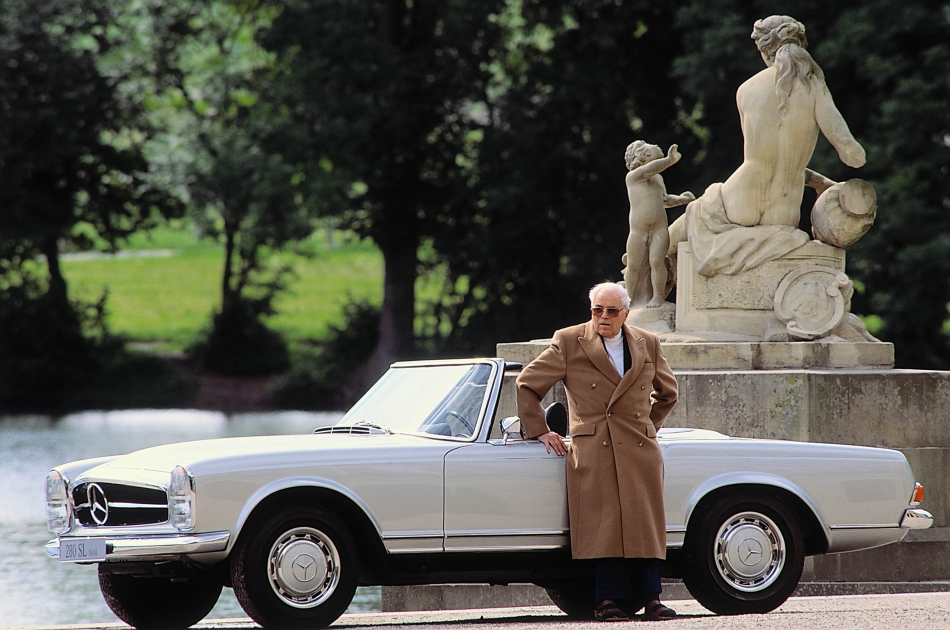The legendary Mercedes-Benz 230SL model was an outstanding example of the global automotive industry. Brand’s fans remembered it as a unique representative of the cult brand’s series of unrivaled light sports cars.

Source: Vintage Car Collector
The years after the Second World War were not easy for anyone, but even more so for Germany. However, the German automotive industry not only survived but flourished: not limited by the production of civilian cars, the brand released remarkable models of racing cars. One such sports car was the 1952 W194, which competed in the 24 Hours of Le Mans, Mille Miglia, Carrera Panamericana, and other major motorsport events with brilliant results. The W194 became very popular due to its victories, and in 1953 the management of the brand decided to create a civilian version of this racing car. Thus, in the 54th year, the world saw the 300 SL, which was called W198 according to the factory classification, the predecessor of our hero 1966’s model. W198 was assembled by hand and the production was small (1400 coupes and 1858 convertibles were created during the entire production period), but the demand was so high the Mercedes managers decided to put into production a simpler version in 1955 and called the affordable version 190 SL. Unlike its older brother, the “one hundred and ninetieth” did not have racing blood in its veins, but was built based on a conventional sedan and was equipped with a modest 1.9-liter 105-hp engine. However, the resemblance to the much-loved W198 played a role, and all 25,881 copies of the 190s were successfully sold out. Both the 300 and 190 SLs were assembled until 1963 and are highly valued by collectors these days.

Source: Drive My
By the early 60s, the first generation of this class was still considered a style icon, but new trends required changes, which led to the creation of the second generation’s Mercedes-Benz 230s. Compared to the first-generation 300 and 190 SLs, which were too expensive and not fast enough, respectively, the second generation 230, released in 1963, was built on a shortened platform of the W111 sedan and was designed by the young French designer Paul Bracq. He created a very laconic image, without unnecessary decor and with a predominance of flat surfaces, which at that time was quite bold. At first, the novelty was seriously criticized. The car was nicknamed “pagoda”, as it resembled the architecture of Chinese religious buildings with the same name. Bracq made the roof slightly concave to increase the height of the low body door openings. But after a while, the model turned into a real style icon, and stars such as Sophia Loren, Stirling Moss, and John Lennon did not consider it shameful to own such a car.
Then, the 1966 230 models appeared, which had the same power as the first “230”, but with more torque. Outwardly, the cars were identical, and only the working volumes of the power units differed. The creators wanted to make something both sporty and comfortable, and they succeeded.

Béla Barényi – the pioneer of passive safety
Source: Mercedes-Benz Group Media
In addition to Bracq, the other key figure was engineer Béla Barényi, a security specialist who received many patents for various inventions and even tried to sue Ferdinand Porsche for the design of the famous Beetle. He did not succeed in the latter, however, that did not detract from his achievements. SL230 owes its success to Barényi who made the second-generation (1963-1967) Mercedes of this class – the world’s first safe sports car where the principles of passive safety were implemented. In 1966, a sports car’s load-bearing body had a rigid cabin cage and controlled deformation zones, interior elements were made safe, and the steering column was folded on impact. Among these principles is the structure of the body, in which the middle part, where the passengers are located, is as rigid as possible, and the front and rear of the car are easily crushed in a collision, thereby absorbing the impact force. Since 1966, vehicles for the American market have been fitted with three-point seat belts as standard. But in terms of dynamics, at first glance, a step back was taken: initially, a 2.3-liter in-line “six” with distributed fuel injection developed 150 hp. However, thanks to its modest weight and well-tuned chassis, the car turned out to be very nimble: to prove this, chief designer Rudolf Uhlenhaut at the wheel of a standard Mercedes-Benz 230 SL went to the race track along with a professional racer who piloted a 200-hp Ferrari 250GT, – and almost did not fall behind. In 1966, a version of the SL250 with a more high-torque engine was produced, by 1967 it was bored out to 2.8 liters and 170 hp, and in 1968 a 206-horsepower Wankel rotary engine was installed on the coupe.

Source: Pinterest
1966 Mercedes-Benz 230SL was featured in such movies as Assassination (1967), Le evase – Storie di sesso e di violenze (1978), A Lovely Way to Die (1968), The Strange Affair (1968), and much more.
If you have a 1966 Mercedes-Benz 230SL or any other classic car for sale, contact us!